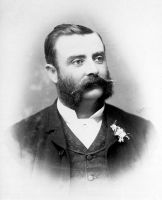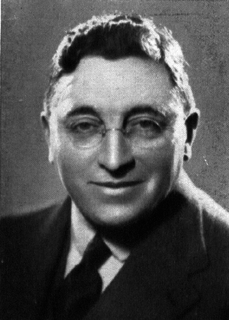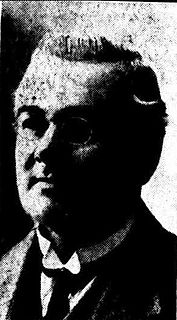
William Henry Ellerker (died 1891) was an architect and politician in Melbourne, Victoria, Australia. He was Mayor of St Kilda. [1]

William Henry Ellerker (died 1891) was an architect and politician in Melbourne, Victoria, Australia. He was Mayor of St Kilda. [1]
Ellerker was born in England. [1]
In 1853 Ellerker immigrated to Melbourne and was employed by architect Thomas Kemp within a few weeks of his arrival. [1]
In 1857 he was elected as an Associate of the original Institute of Architects in Melbourne, then later as a Member and Fellow. In March 1886, he took a 13-month trip to England where he was elected a Fellow of the Royal Institute of British Architects. [1]
In 1863, he moved to Brisbane, Queensland. He submitted a design for the Queensland Parliament House, which was the initially preferred design. [2] However, on advice from architect and politician James Cowlishaw, Ellerker's design and all others were rejected. Amidst controversy regarding the role of Queensland Colonial Architect, Charles Tiffin, in the process, another design (by Tiffin himself) was selected. Ellerker returned to Melbourne in 1866. [1]
Ellerker initially lived in South Melbourne but later relocated to St Kilda. There he took an interest in local affairs. He was the correspondent for the local board of advice for three years. In 1881 he was elected as a councillor in the Borough of St Kilda's North ward, after which he was unanimously elected as Mayor of St Kilda. During his tenure, St Kilda was part of the redevelopment of Princes Bridge, contributing £10,000. He was also involved in protecting Albert Park from further residential development. When his term as mayor was over, he was presented with an illuminated address in appreciation of his contributions. [1]
Ellerker was a prominent Freemason and Orangeman. [1] In 1886, he was appointed a Justice of the Peace. [1]
Ellerker died on Monday 30 March 1891 at his residence in Crimea Street, St Kilda following a period of ill health. His funeral was held on Wednesday 1 April 1891 at the Melbourne General Cemetery. [1]
Ellerker's significant works include:

Toorak is an inner suburb of Melbourne, Victoria, Australia, five kilometres (3.1 mi) south-east of Melbourne's Central Business District, located within the City of Stonnington local government area. Toorak recorded a population of 12,909 at the 2016 Census.

William Pitt was an Australian architect and politician. Pitt is best known as one of the outstanding architects of the "boom" era of the 1880s in Melbourne, designing some of the city's most elaborate High Victorian commercial buildings. He worked in a range of styles including Gothic Revival, Italianate, French Second Empire, and his own inventive eclectic compositions. He had a notable second career after the crash of the 1890s, becoming a specialist in theatres and industrial buildings.

Parliament House in Brisbane is the meeting place of the Parliament of Queensland, housing its only chamber, the Legislative Assembly. The building was the site of the world's first socialist government in history. It is located on the corner of George Street and Alice Street at Gardens Point in the CBD, and is next to the Queensland University of Technology and City Botanic Gardens.
Sir Roy Burman Grounds was an Australian architect. His early work included buildings influenced by the Moderne movement of the 1930s, and his later buildings of the 50s and 60s, such as the National Gallery of Victoria and the adjacent Victorian Arts Centre, cemented his legacy as a leader in Australian architecture.

John James Clark, an Australian architect, was born in Liverpool, England. Clark's 30 years in public service, in combination with 33 in private practice, produced some of Australia's most notable public buildings, as well as at least one prominent building in New Zealand.
Australian non-residential architectural styles are a set of Australian architectural styles that apply to buildings used for purposes other than residence and have been around only since the first colonial government buildings of early European settlement of Australia in 1788.
James Birrell (1928-2019) was an architect responsible for the design of significant buildings in Queensland, Australia. James Birrell practiced from 1951 to 1986.

Robert Smith (Robin) Dods was a New Zealand-born Australian architect.
Hudson and Wardrop was formed by Philip Burgoyne Hudson and James Hastie Wardrop in 1919. Hudson was born in Auckland, New Zealand on 6 February 1887 and died in 1952 at the age of 64. James Wardrop was born in 1891 and died on 25 July 1975 at the age of 84. Both architects were veterans who served in the war and moved on to study under Charles D'Ebro. The Australian established architects are well known for their designs of chapels, universities, colleges, factories, hotels, and public monuments in Melbourne, the Shrine of Remembrance being the most prominent out of the few. They were also responsible for the compiling of The National War Memorial of Victoria: the first brochure on the first permeated design.
Charles Tiffin (1833–1873) was an English architect, who spent most of his career in Queensland, Australia where he held the post of Queensland Colonial Architect.

Joseph Plottel was a British born architect who was active in Melbourne, Australia between 1911 and World War II, working in a range of revival styles, as well as Art Deco in the 1930s. He is best known for the St Kilda Synagogue (1927) and the Footscray Town Hall (1936).
Andrea Giovanni Stombuco (1820-1907) was an Italian-born Australian sculptor and architect. Many of the buildings he designed are listed on the heritage registers in Australia.

George Henry Male Addison (1857–1922) was an Australian architect and artist. Many of his buildings are now heritage-listed.
Mordechai Benshemesh was a noted architect who practiced in Melbourne, Australia from the 1950s to the 1970s. Born in Palestine, he was one of a number of often Jewish émigré architects who migrated to Australia both before and after WW2 who brought a different approach to architecture, as well as an appreciation of apartment living. He is best known as the architect for one of the city’s first high rise modernist apartment blocks, Edgewater Towers in St Kilda.
Teneriffe House is a heritage-listed villa at 37 Teneriffe Drive, Teneriffe, City of Brisbane, Queensland, Australia. It was designed by William Henry Ellerker and built in 1865. It was added to the Queensland Heritage Register on 14 May 1993.

Toorak House is a heritage-listed villa at 28 Annie Street, Hamilton, City of Brisbane, Queensland, Australia. It was built from c. 1865 to 1915. It was added to the Queensland Heritage Register on 2 March 1994.
Isidor George Beaver, often misspelled "Isidore" and frequently initialized as "J. G. Beaver", was an architect from England who had a substantial career in Adelaide, South Australia and Melbourne, Victoria. He was significant in the early history of ice skating in Australia.
Hedley Allen Dunn was a South Australian architect, a member of the prominent Dunn family of Mount Barker. His work included the flour mill at Port Adelaide for his father and grandfather in 1886, and the Stock Exchange Building on McHenry Street, off Grenfell Street, Adelaide, in 1900.

Henry Eli White, also known as Harry White, was a New Zealand-born architect who is best known for the many theatres and cinemas he designed in Australia and New Zealand in the 1910s and 1920s. Many of the major surviving historic venues in the two countries are White designs, including the St. James Theatre, Wellington, St. James Theatre, Auckland, the Capitol Theatre and State Theatre in Sydney, and the Palais Theatre and the interiors of the Princess Theatre and Athenaeum Theatre in Melbourne. He also designed the City Hall and the attached Civic Theatre in Newcastle, New South Wales.
Sydney Wigham Smith was an architect in Melbourne, Australia, principal of the firm of Sydney Smith, Ogg and Serpell.
{{citation}}: CS1 maint: multiple names: authors list (link) ![]() Media related to William Henry Ellerker at Wikimedia Commons
Media related to William Henry Ellerker at Wikimedia Commons